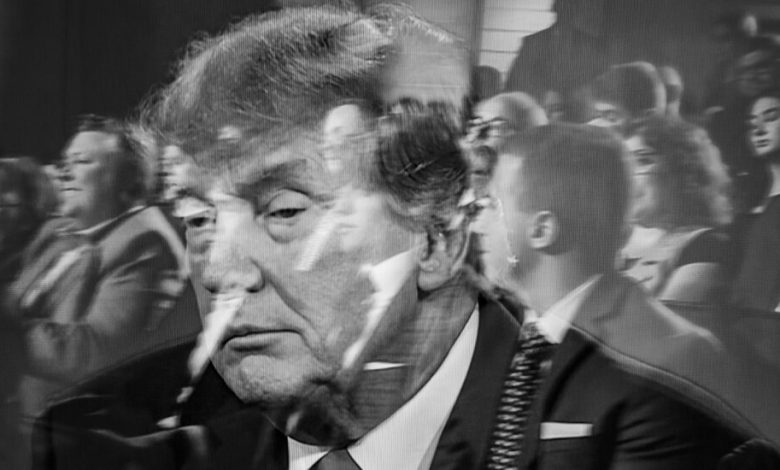The Most Important Trial in U.S. History Should Be Televised

The only issue that Americans on all sides of our vast political divide seem to agree on is that we cannot agree on anything. Even basic facts have become matters of opinion.
It is a fact, not an opinion, that Bill Gates did not mastermind a plot to embed microchips into Covid vaccines so that Americans could be tracked and their minds controlled. But polls indicate that about one-fifth of all Americans believe the microchip conspiracy theory to be true or are unsure whether it is true.
It is a fact that Hunter Biden’s laptop was real, not part of a Russian disinformation campaign. But a poll taken nearly three months ago, long after The New York Times and others confirmed that the laptop was real, found that 41 percent of Americans, including 59 percent of Democrats, still did not believe it was.
In the work I do looking at the reliability of online news and information, I can see that the erosion of trust in basic facts is largely the result of too many people getting their news from social media platforms. What they see there may be highly opinionated, one-sided, boiled down to a few words or catchy phrases, or taken out of context, come from people with undisclosed credentials or agendas, or be just plain made up. And it’s all sorted out and presented by algorithms designed to engage them to spend more time on the platform by offering up content that will excite rather than inform, and please them rather than challenge them, by reinforcing what they already believe.
What’s presented to jurors in a courtroom has the opposite qualities. Court is a quiet, somber sanctuary, where rules prevent the disorienting chaos we experience online. Jurors are made aware of the credentials and possible biases of witnesses. Documents and other exhibits are painstakingly authenticated. The admissibility of evidence is carefully vetted by a judge, and after a lawyer on one side is allowed to present it, a lawyer on the other side can then challenge it, with both lawyers strictly limited by rules not allowing them to present hearsay or rumors or offer their opinions.
In the 1980s, as a journalist reporting on the law, I interviewed jurors after their trials to find out how they had reached their verdicts. After a while, one thing struck me as unusually consistent: Jurors said that after sitting on juries they were surprised by how much more favorably they thought of our justice system. When they got to see the system up close and at full length — instead of how it was displayed on the 11 o’clock news (this was well before we all went online), with sound-bite spins from lawyers on the courthouse steps or prosecutors at a news conference — they decided that it worked well. That it did a good job sorting out the truth. More than one juror told me that it was something we should all be proud of.
In 1991, I started the cable network Court TV to provide that same unobstructed view of the American justice system. People at home could watch what jurors watched instead of being spun by headlines, dueling news conferences or courthouse-steps sound bites. I pointed out that in the 19th century courthouses had been built with large seating areas for people in town to come watch trials, which under the Constitution were supposed to be public. In the 20th century, an unobtrusive camera beaming a trial out to the community was the right modern update and, in fact, a more effective way to keep faith with the founders’ view that trials should be publicly accessible.
Although my constitutional argument was never widely accepted, by the time I left Court TV in 1997, a clear majority of states allowed cameras in their courts in one way or another. Some judges still opposed cameras. Many lawyers, especially some defense lawyers in criminal cases and product liability civil cases, opposed cameras, too. Nonetheless, cameras had become the rule, not the exception, in state courts.
The federal courts are a different story.
Sometime this year or next, a Federal District Court in Washington, D.C., will likely be the scene of what may be the most consequential trial in the nation’s history. A jury will have to decide whether a former president of the United States is guilty of plotting to corrupt the democratic process and overturn an election.
Federal court rules do not allow cameras in any criminal trials. However, no matter which side of this Donald Trump case you may be rooting for, you should want those rules to be suspended so that this trial can be televised live.
The last thing our country and the world needs is for this trial to become the ultimate divisive spin game, in which each side roots for its team online and on the cable news networks as if cheering from the bleachers. Much of that would still happen, but imagine how a quiet, methodical, but sure-to-be-riveting presentation of both sides’ arguments — subject to the rules of evidence and decorum of a federal court, not the algorithms of Facebook and Twitter — might temper the national mood when a verdict is announced. At the least, it will make people more informed about what could be the single most important activity their government will conduct in their lifetimes.
An ancillary benefit to setting up one silent pool camera in the back of the courtroom and sending a feed to all media outlets around the world that want it is that it would give the judge and court administrators a good rationale for pushing away from the courthouse the likely circus outside. The scrum of cameras and journalists — gathered for the trial of the century, but unable to give their audiences a full picture of what is happening inside, and trying to get offhand comments from one of the lawyers on the case or from the mass of lawyer-pundits who wish they were on the case — is otherwise likely to make the chaos of past high-profile trials look placid.
Of course, the cable networks arrayed on each side would still have their lawyer-pundits spinning for or against Mr. Trump. But these cable channels and websites, unwilling to risk losing their audiences, would likely also livestream the actual trial as it proceeds. I know from experience that the ratings for this live action will likely dwarf the audiences for in-studio talking heads.
As a result, detractors of Mr. Trump logging on to their favorite websites or watching their favorite news channels would have to see and confront the defense argument that there is not sufficient evidence that Mr. Trump knew he lost the election, which almost certainly must be proved beyond a reasonable doubt to convict him on any of the charges he faces. These are truly strong arguments. That may surprise many Trump haters, given their likely current media diets. They need to be better informed.
Mr. Trump’s defenders, on the other hand, would have to confront the fire hose of detailed evidence of multiple plots to overturn the election, which were outlined convincingly but sparingly in an indictment that few of them have likely read. That, too, is evidence that might not be available in their regular media diets. In fact, they may not have even seen or heard anyone describe the details of the indictment. But they will if they see the trial.
Suspending the rule against cameras in federal criminal trials will not be easy. In fact, it requires suspending three rules. First, the U.S. Judicial Conference, chaired by the Supreme Court’s chief justice, John Roberts, and consisting of the chief judges from each of the country’s appellate circuits and the Court of International Trade and trial judges from each of those circuits, would have to vote to suspend its nationwide rule against cameras in federal criminal trials. The judicial council of the District of Columbia Circuit has its own rule, which would then have to be suspended. And then the federal rules of criminal procedure, which also prohibit cameras, would have to be changed.
That is a lot of hurdles to overcome in forums that have not traditionally favored public access to the courts, especially for criminal proceedings. But there are months, maybe even a year or more, to persuade those in charge that this is a unique situation that defies tradition and demands an exception. It’s an exception that even partisans on each side, including Mr. Trump, should welcome, because it is the only sure way that each side will get the other to see its arguments unfiltered. More than that, it’s the exception that will provide everyone with the facts.
What the jurors decide will likely be debated by the rest of us forever. We should be debating their verdict using the same set of facts that they saw.
Steven Brill founded Court TV and is a co-chief executive of NewsGuard. His book “The Death of Truth” is forthcoming.
The Times is committed to publishing a diversity of letters to the editor. We’d like to hear what you think about this or any of our articles. Here are some tips. And here’s our email: [email protected].
Follow The New York Times Opinion section on Facebook, Twitter (@NYTopinion) and Instagram.



